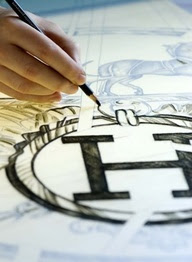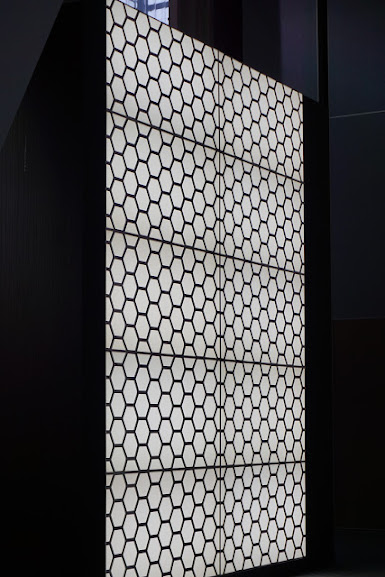A Look At Historical, American-Made Fabric, Folly Cove

innovator Virginia Lee Burton
You may remember Virginia Lee Burton as she was a children's book author and illustrator in the 1930s, but her creativity didn't end there. She went on to design textiles in the small enclave of Gloucester, Massachusetts by using a unique technique of hand carved linoleum blocks for printing.
Do you know about Folly Cove Fabric?
Virginia brought together a group of women- designers; neighbors and housewives in the sleepy fishing village of Gloucester and taught them this unique technique of block printing fabric, and together they formed a historic guild of artisans.
I love Gloucester, Massachusetts!
.jpg) |
| my mother's little beach house on Rackliffe Street in Gloucester |
For fifteen years, my mother lived in the artist colony overlooking the ocean in Gloucester. This special nook in Gloucester is called Rocky Neck. I've posted about her former Sea Captain's house before, and it is juxtaposed on a corner between two streets, each with views of the water. Her cottage had a beautiful garden and was a perfect vantage point to watch the fishing boats as they meandered out to sea. One of our favorite activities to do together when I visited Gloucester was to drive around the many little communities tucked into the bigger town of Gloucester. We would marvel at the beauty: the artist colonies, the new england architecture and natural beauty which has been mostly preserved and is still astounding today. My mother especially loved the curvy country roads of Lanesville.
At the time, I did not know about the history behind Folly Cove fabric, but was attracted to the interesting Arts and Craft motifs I found in many local shops in the form of paper, notecards and hand towels. It wasn't until two years ago in my own home in East Hampton, Long Island that I learned about Folly Cove. As I walked through the local East Hampton Antiques & Design show set in the bucolic historic farm, Mulford Farm, I met an antique dealer and collector named Andrew Spindler. Since then, I have written about Andrew's shop in Essex and his wares and collections in Dan's Papers magazine and here on Nest by Tamara. Andrew has a sophisticated eye for curating unique antiques from various time periods. I was drawn to two framed works and he told me about Folly Cove. He had samples of fabric mounted on paper, the originals from the 1940s. Andrew and I chatted about the amazing history in Gloucester, and the many decorative and fine artists that have long been drawn to the community. This month's topic of fabric, wallpaper and furniture was a perfect time to bring this story to my viewers.
INTERESTING HISTORY BEHIND FOLLY COVE -In 1938, Virginia sewed curtains for her writing studio in Lanesville. She used linoleum because it was an inexpensive way to block the fabric. The designs were cut into the linoleum, inked, and then printed on cotton fabric. At the time, Jinnee (Virginia's nickname ) did not own a press so she simply jumped up and down on the block to print on the fabric. After her neighbor admired the curtains and asked for a block printing lesson, Virginia began to teach the process to others. Two years later in 1940, the textile collective, The Folly Cove Designers, was established.
Interestingly enough, Virginia styled her newly formed guild after a medieval guild, and the Folly Cove Designers departed from the tradition of signing their work with the guild's crest or signature and instead opted to include the individual artist's name, giving a personal touch to the work. In 1943, the Guild acquired Acorn presses used to pull prints and no longer resorted to jumping on the blocks.
Soon, Virginia's course became a popular, yet serious journey for those lucky enought to attend her classes. Once the design was submitted to a jury of designers and approved, it was displayed in their studio and part of the prestigious Collection. This guild of artists became celebrities of sorts in Gloucester, and their local annual exhibition presenting their latest designs became recognized beyond New England. Their works were being offered to the America House of New York, established by the American Craftsman Cooperative Council.
New York was taking notice: the department store Lord & Taylor bought the rights to five designs in 1945. The Guild opened a retail outlet called "The Barn" in 1948 to sell their wares in Gloucester during the summer months. Sadly, with Virginia's death in 1969 the Guild ended this cooperative of innovative and unique collaboration of women. A local non-profit organization, The Cape Ann Historical Association located in Gloucester is now the primary source for information about the Folly Cove Designers.

Folly Cove - a distinct fabric with repetitive patterns


Virginia brought together an
interesting group of creative women, formed a guild in the 1940's
Virginia's Inspiration...
Virginia was inspired by the surrounding beauty in nature. She encouraged her designers to take from the local Cape Ann environment - the flowers, ocean and all that surrounded them in the area. There was repetition, various sizes and juxtapositions of black and white in her designs. There was a strong emphasis on the artistry and craftsmanship of carving the linoleum and later printing. Their art was commissioned individually, but the guild was also producing useful and beautiful home products-- wallpapers, draperies, tablecloths, hand towels and more.
Folly Cove designers came about during a renewed interest in the Arts and Crafts movement that had started in the 1800s in England. Life magazine featured a story about the Guild in 1945. They went on to host many exhibit throughout the United States. Today, The Museum of Fine Arts in Boston and the Peabody Essex Museum in Salem have works of The Folly Cove Designers. The Print Collection at the Metropolitan Museum of Art acquired samples of The Folly Cove Designers wallpaper. However, the largest holding of The Folly Cove Designers work is at The Cape Ann Museum in Gloucester. They are on display in The Folly Cove Auditorium
Vogue magazine ran a story several years ago which regenerated more interest in the fabric, Vogue Story
His booth at The East Hampton Antiques Show at Mulford Farm.
VINTAGE FOLLY COVE TEXTILE IN THE "HOME PORT"PATTERN, BY LOUISE KENYON, CIRCA 1949 AND HAND BLOCK PRINTED ON COTTON BY THE FOLLY COVE DESIGNERS IN GLOUCESTER, MA.
Archivally framed.
Height: 16 7/8”
Width: 21 3/8”
Visit with antique dealer and historian Andrew Spindler at his lovely shop in Essex, Massachusetts. Andrew is one of the largest collectors and dealers of Folly Cove.
history and photograph material curated from the following sources:

















